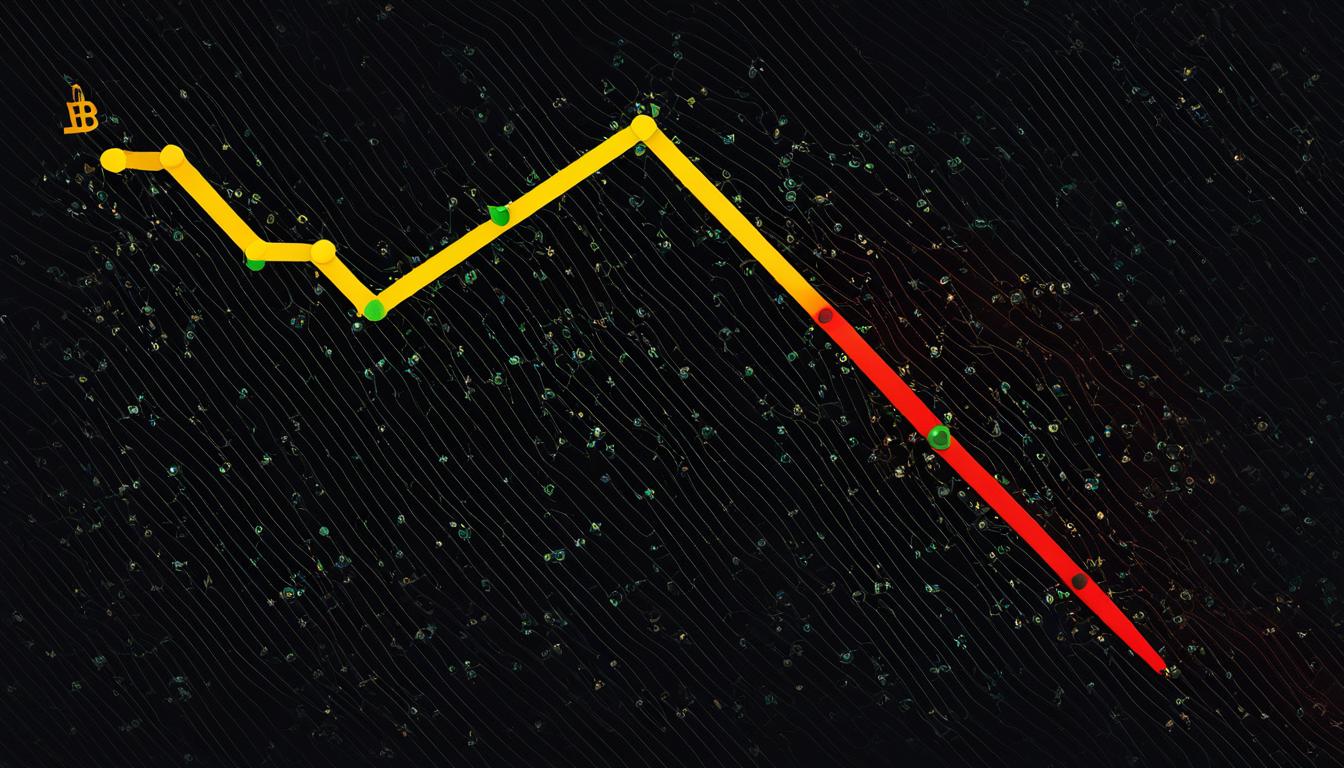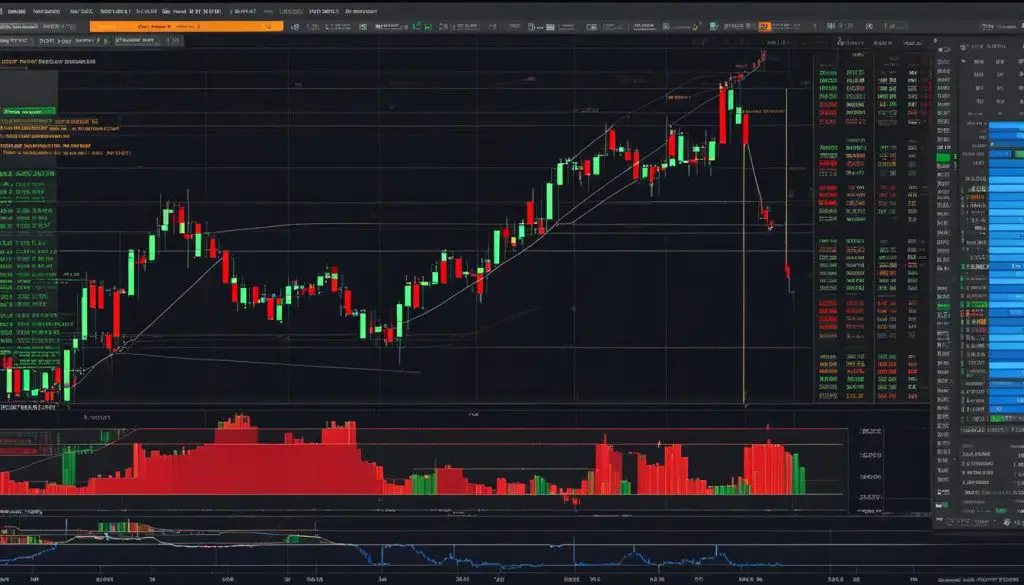In the dynamic realm of cryptocurrency trading, the key to maximizing returns often lies in the ability to recognize and interpret market signals. Among the various technical indicators at a trader’s disposal, the crypto flag pattern stands out as a notably reliable predictor of future price movements, offering insights into potential breakouts and trend continuations. These cryptocurrency flag patterns are broadly categorized into bullish and bearish, each with its distinct implication on market behavior.
The concept behind flag patterns in cryptocurrency is straightforward yet profound: a trader discerns a flag pattern when the market price consolidates between two parallel trendlines, soon to be followed by a significant breakout that mirrors the direction of the preceding trend. This consolidation can either trend upwards, forming a bullish flag, or trend downwards, creating its bearish counterpart. Trading these flag patterns involves meticulous attention to their structure, timing entries and exits with precision, and applying comprehensive risk management strategies to mitigate potential losses.
As an essential tool in technical analysis, understanding how to identify and react to these patterns can serve as a cornerstone in the foundation of a successful trading strategy. Insightful recognition and strategic operation within these patterns pave the way for informed decision-making and potentially lucrative opportunities in the ever-evolving cryptocurrency markets.
Introduction to Trading with Crypto Flag Patterns
As the digital asset landscape continues to evolve, savvy traders are utilizing sophisticated tools to stay ahead, with flag patterns in the crypto market serving as a lynchpin in this tactical armory. A flag pattern analysis in cryptocurrency not only enriches the strategic toolkit of traders but also offers a glimpse into the underlying sentiments driving market dynamics. What follows is a deeper dive into the architecture of these patterns, their significance, and methods for integrating them into trading practices. Understanding these formations could significantly enhance decision-making processes in the fast-paced world of cryptocurrencies.
What Are Crypto Flag Patterns?
Crypto flag patterns, distinguished within technical analysis, provide traders with pivotal insights into market trends. Manifested through a rectangular consolidation phase and a sizeable prior movement, they are essentially a combination of a ‘flagpole’ and a ‘flag.’ These patterns take shape on charts during periods of less volatility that follow decisive price actions, offering clues on the continuation of the current trend. Both bull flag and bear flag patterns comprise a flagpole, representing a swift price change, and a flag, which depicts a sideways or slightly sloped consolidation that appears counter to the prior trend.
Significance of Flag Patterns in Crypto Trading
Flag patterns are not just common formations on charts but are staple tools in the trader’s kit due to their predictive prowess. They aren’t merely abstract shapes; these patterns serve as a reflection of ongoing market momentum and investor sentiment. Traders often employ flag patterns for their ability to suggest potential breakouts and trend continuations, thereby making them instrumental in planning entries and exits in the volatile cryptocurrency market.
The Basic Structure of Flag Patterns
The core component of a flag pattern is its standardized structure which, once recognized, allows for a systematic approach in execution. In bullish markets, a flag pattern speaks of potential upwards trajectory post-consolidation, conversely indicating downward momentum in bearish settings. Despite their differences, both bear and bull flags present traders with the opportunity to harness these expected continuations to align with prevailing market trends, fostering calculated and informed trading operations in the cryptocurrency domain.
Decoding the Bullish Crypto Flag Pattern
The bullish flag pattern is a powerful formation in the world of cryptocurrency trading. Not only is it seen as a predictive signal of an impending price increase, but mastering the trading bull flag patterns can be particularly rewarding. Here, we dive into the intricacies of this technical setup and provide practical advice for leveraging crypto bull flag signals to your advantage.
A Bull Flag typically emerges following a robust, vertical rise in price, which forms the ‘flagpole’. The flag itself is a period of consolidation, marked by smaller price movements contained within parallel lines sloping downwards. Identifying this pattern early is paramount for traders aiming to capitalize on a subsequent breakout, which often results in a continued upward trend.
- Observe the initial surge in price that signifies the flagpole.
- Watch for a consolidation that defines the flag, accompanied by decreasing volume.
- Wait for a breakout above the flag with higher volume for confirmation.
Strategic trade execution is crucial when dealing with bull flag patterns. Here is a step-by-step outline to follow:
- Verify the pattern: Confirm the presence of both a flagpole and a flag.
- Wait for the breakout: Exercise patience for the price to break above the flag.
- Place stop-loss orders: To manage risk, set a stop-loss order below the lowest point within the flag area.
- Monitor the market closely: Always keep an eye on the trend to ensure it doesn’t reverse.
To further illuminate the concept, let’s examine some real-world trading examples with historical data showcasing successful Bull Flag trading:
| Crypto Asset | Flagpole Length | Flag Duration | Volume Increase (%) | Post-Breakout Price Surge (%) |
|---|---|---|---|---|
| Bitcoin (BTC) | 15% | 2 weeks | 120% | 10% |
| Ethereum (ETH) | 18% | 10 days | 115% | 15% |
| Litecoin (LTC) | 20% | 3 weeks | 80% | 22% |
The evidence is clear: when the bullish flag pattern manifests, the probability of an upside move increases significantly. Learning to trade these patterns demands a blend of patience, discipline, and a keen eye for volume changes alongside price action. Master these skills, and trading bull flag patterns may very well become a cornerstone of your trading strategy.
The Bearish Counterpart: Analyzing Bear Crypto Flag Patterns
In the dynamic world of cryptocurrency trading, understanding the patterns that frequently emerge on price charts can be crucial to a trader’s success. Among these, the bearish flag pattern offers key insights into market trends, particularly those pointing to downward momentum. A thorough bearish crypto flag analysis can arm traders with the foresight needed to navigate the volatilities of a bearish market.
Identifying Bear Flag Formations
To adeptly identify a bearish flag pattern, investors must first note the creation of a significant downtrend, referred to as the flagpole. This is rapidly followed by a slight, parallel price recovery, forming what resembles a flag. Though this recovery may seem like a change in market direction, careful analysis often reveals that it is merely a minor pause in a larger bearish trend. The consolidation phase of higher lows and lower highs within the flag formation aids traders in predicting potential movements and preparing for the next price action.
Strategies for Trading Bear Flag Patterns
The approach to trading bear flag patterns requires diligence and a strategic methodology. Key is the placement of sell-stop orders just below the flag’s consolidation area. This tactic hinges on the expectation of price continuing to decline, hence entering a short position once the flag’s lower boundary is breached. Additionally, setting up a stop-loss order above the flag formation limits potential risks, guarding against any abrupt shifts in market direction. Traders often supplement their technical analysis with indicators like RSI (Relative Strength Index) or MACD (Moving Average Convergence Divergence) to validate the continued strength of a bearish trend before capitalizing on the bear flag structure.
- Locate flagpole following a strong downward price movement
- Analyze consolidation pattern for characteristics of a bear flag
- Set sell-stop orders beneath the flag’s low
- Place stop-loss orders above the flag to mitigate risks
- Use RSI or MACD to confirm trend’s momentum before entry
Observing these steps carefully and executing a planned strategy allows for capitalizing on the downtrend signaled by a bear flag, which, when navigated correctly, can lead to substantial gains in bearish markets.
Strategic Entry and Exit Points in Crypto Flag Pattern Trading
In the pursuit of mastering crypto flag pattern strategy, the acumen to designate strategic entry and exit points in crypto flag patterns cannot be overstated. These fulcrums of trade execution are the linchpin in ensuring not just the success of a single trade, but the overall resilience and growth of a trading portfolio. Let’s delve into the specifics of effectively positioning buy-stop and sell-stop orders and timing your trades for an impeccable execution in cryptocurrency flag pattern trading.
Setting Up Buy-Stop Orders in Bull Flags
In the case of a bullish flag, the trader’s strategy is to await the price action to move upwards through the descending trendline that characterizes the flag pattern. Setting a buy-stop order just above this trendline may secure a position in anticipation of the upward breakout, potentially capturing the renewed bullish momentum. Coupling this with a stop-loss order, judiciously placed below the lowest point reached within the flag formation, forms a defense mechanism against downward price fluctuations, thereby limiting potential loss.
Placing Sell-Stop Orders for Bear Flags
Conversely, when observing a bear flag, an effective strategy involves positioning a sell-stop order beneath the ascending trendline, which denotes the lower edge of the flag. This action predicates on catching the early stages of a potential downtrend continuation. Just as critical is to affix a stop-loss order above the flag’s highest point to mitigate loss in the scenario of an inverse price trajectory. The conviction to act upon these entry and exit points in crypto flag patterns is what separates skilful trading from mere speculation.
Timing Your Trades for Optimal Execution
Timing plays a pivotal role in the context of trading flag patterns; it is the subtlety that harmonizes with volatility, ensuring that trades are placed when conditions are most favourable. Trades on smaller timeframes might react swiftly, demanding constant vigilance, whereas trades anchored in larger timeframes offer a wider window, necessitating confirmation from volume indicators and breakout strength to substantiate the position. This layered approach intertwining entry and exit strategies with meticulous timing elevates the trader’s capacity to exploit a crypto flag pattern strategy to its fullest extent.
FAQ
What Are Crypto Flag Patterns?
Crypto flag patterns are technical analysis tools used in cryptocurrency trading to identify trend continuations. They consist of a rectangle-shaped consolidation phase, known as the “flag”, succeeding a sharp price movement, referred to as the “flagpole”. These patterns indicate potential future price movements and are categorized as bullish (Bull Flags) or bearish (Bear Flags) depending on the preceding trend.
What is the Significance of Flag Patterns in Crypto Trading?
Flag patterns are significant in crypto trading as they serve as indicators for potential trend continuations. They represent a brief consolidation before the market resumes its preceding trend. Bull flags suggest the likelihood of an upward price continuation, while bear flags indicate a possible downward movement. Their frequent occurrence and ease of identification make them valuable for traders aiming to capitalize on trend momentum.
How Does a Bullish Flag Pattern Work in Cryptocurrency Trading?
A bullish flag pattern in cryptocurrency trading indicates that a prior upward trend is likely to continue after a brief consolidating phase within the flag. Traders look for a sharp rise in price to form the flagpole, followed by a downward sloping consolidation. A high-volume breakout from this consolidation signals traders to consider taking a long position in anticipation of an upward price trend continuation.






